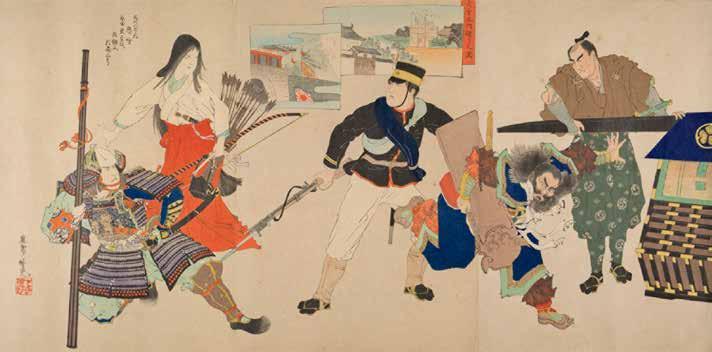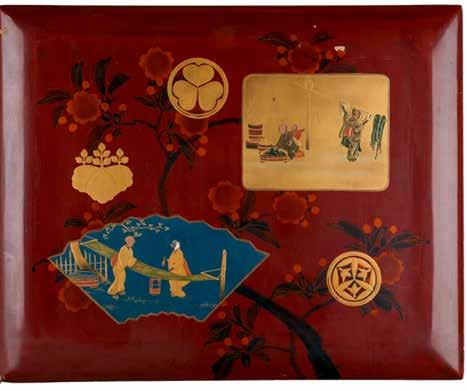
9 minute read
The samurai in a modern world
Russell Kelty
What Japan was she owed to the samurai. They were not only the flower of the nation but its root as well. All the gracious gifts of heaven flowed through them. 1
Advertisement
The restoration of the Emperor and the establishment of his ‘enlightened government’ in 1868 initiated an artistic and cultural revolution in Japan. The Meiji era (1868–1912) is defined by the Japanese empire’s rapid ascension on the world stage due to modernisation and technological innovation. Art was considered an essential part of the government’s ambitions to present Japan as a modern nation and thus avoid the perils of colonisation that had befallen the Qing dynasty (1644–1911). Under the slogan, ‘Enrich the country, strengthen the military’ (fukoku kyōhei), the new government actively encouraged artists to create objets d’art on a par with those of industrialised nations for display at international exhibitions in America, Australia and Europe.
This revolution meant the official end of the reign of the shogun, daimyo and samurai. In 1876 the right to wear swords in public was banned, and many young samurai, realising the need for reform to the military and society, gladly cut off their top knots, donned Western clothing and joined the bourgeoisie. In addition to forming the new Japanese military, ex-samurai also became civil servants, teachers, merchants, farmers and artists, enacting a successful self-transformation from samurai estate to modern office holder. The previous function of the samurai was replaced by a conscripted army, who wore Western military uniforms and who were trained by Western experts. Once the top of the social hierarchy, the samurai had now lost their class, privilege and vast estates. The old view of the samurai as a tool of society was transformed: they were now seen as an army which acted as the protective force of the fabric of a society menaced from abroad by real and imagined internal subversion. 2
The samurai may well have been deposed, but they cast a long shadow on modern Japan. Authors such as Inazō Nitobe constructed an idealised samurai for Western audiences, with the aim of countering the critical response to Japan’s growing military power in East Asia. Bushidō: the soul of Japan was first written in English and published in Philadelphia (1899) and translated into Japanese in 1909. ‘Bushidō’ literally translates to ‘the way of the warrior’ and is largely based on Western ideas of chivalry rather than on the specific code of conduct conceived during the Edo period. 3 Nitobe ‘attributes the foundation and flourishing of the national soul to the samurai ancestors’ and attempted to forge a distinct and unique Japanese identity in order to explain ideals and values from Japan’s past. Bushidō was highly influential in Japan and the West, with presidents such as Theodore Roosevelt (1858–1919) and John F. Kennedy (1917–1963) reading it in an attempt to understand the new rising power.
1
2 Inazō Nitobe, Bushidō: the soul of Japan, Cosimo Classics, 2007, p. 67. L.M. Cullen, A history of Japan, 1582–1941: internal and external worlds, Cambridge University Press, Cambridge, 2003, p. 261. Cullen, p. 266.
fig. 1: Kobayashi Kiyochika, Japan, 1847–1915, Scouts near Newchang on a snowy night (Nyūchan fukin yukiyo no sekkō), 1894–95, Tokyo, colour woodblock print (nishiki-e); ink and colour on paper, 35.7 x 69.3 cm; Gift of David Forrest CBE and Jánis Nedéla through the Art Gallery of South Australia Foundation 2019
Andreas Marks, ‘Meiji-period war prints and their publishers’, in Philip Hu, Conflicts of interest: art and war in modern Japan, St Louis Art Museum, St Louis, 2016, p. 25.
The ethos articulated in Nitobe’s book is envisioned in prints depicting the Imperial Army and Navy of Japan as it embarked on a series of military engagements in East Asia. While these encounters defined its place in the world order, at the same time they served to revitalise the woodblock print industry. Woodblock print designers trained during the last flourishing of prints, in the Edo period, began to transform the repertoire of motifs used to portray historical warriors from the nineteenth century to present an idealised vision of the modern soldier, who fought on behalf of the Emperor and the nation of Japan.
War prints (senso-e) were designed from the late 1870s and depict the events and exploits of the Imperial Army in subjugating the samurai class in Japan and, later, foreign forces in China and Russia (fig. 1). The defeat of the Russian Imperial Army was a shocking event for the world community, as it was the first time in the modern era that an Asian country had defeated a European power. The rising popularity of the daily newspapers and their capacity to feature contemporary events, which were banned during the Edo period, had a positive effect on the woodblock print industry. 4 War prints placed a distinctive emphasis on the Emperor and inserted images of the new modern soldier in the lineage of warriors popularised in the woodblock printed books and prints of the nineteenth century.
The woodblock designers of this era often had diverse training due to the decline of the market for prints. The heroics of the modern soldier were presented through the visual language of the newspaper, lithography and photography and imbued with the ethos of the samurai. The samurai of the feudal Edo period, depicted with two swords (daishō) and topknot

(chonmage), now had his hair cut and wore a crisp military uniform with a single sword. The print by Ginkō Adachi displays the samurai and the modern soldier in a lineage of historical and fictional imagery (fig. 2).
One of the most prolific artists to create propaganda during the SinoJapanese and Russo-Japanese wars was Kobayashi Kiyochika (1847–1915) (fig. 3). Kobayashi was born into the lower ranks of a samurai class in Edo, the seat of the Tokugawa government, in 1847. His early print designs display the influence of both the woodblock style of the Edo period and his training in Western printing techniques. 5 Kobayshi, whose prints often feature harsh contrasts of light and dark, as well as perspective, is best known for his designs featuring the valour and chivalrous acts of the modern warrior, whose sabre was always at his side or in his hand. He also created satirical prints critical of the Meiji government.
fig. 2, above: Ginkō Adachi, Japan, 1853–1902, Warriors of Japan, c.1895, Tokyo, colour woodblock print (nishiki-e); ink and colour on paper, 35.7 x 69.3 cm; M.J.M. Carter AO Collection through the Art Gallery of South Australia Foundation 2019
fig. 3, below; Kobayashi Kiyochika, Japan, 1847–1915, Massacre of the Chinese at Asan, 1894, Tokyo, colour woodblock print (nishiki-e); ink and colour on paper, 36.9 x 75.0 cm (overall); M.J.M. Carter AO Collection through the Art Gallery of South Australia Foundation 2019
5 Sonja Hotwagner, ‘Laughter about war in modern Japan: three series of satirical prints by Kobayashi Kiyochika’, in Hu, p. 36.

The samurai or bushi became a symbol of Japan’s dominance on the world stage and the great tales on these themes continued to inspire even children’s games (suguroku) (fig. 4) and dioramas (tatebanko). Lithographs created after the spectacular military success of the Russo-Japanese War (1904–05) present the samurai as a dominant force in East Asian politics and the symbol of Japan, and advocate a return to the spirit of the samurai as a motivating force for the nation. The acts most readily associated with the samurai were encouraged for similar reasons but caused unforeseen responses in the new society.

fig. 4: Tada Hokurei, publisher, active 1900–30, Castle attack game (shirozeme ichibannori suguroku) Tokyo, 1927, colour woodblock print (nishiki-e); ink and colour on paper; Collection of Satoko and Yugen Tomimori
On September 1912, the day of Emperor Meiji’s funeral, General Nogi Maresuke and his wife committed ritual suicide in a display of their devotion and affirmation of the samurai code, whereby an individual followed their lord into death (junshi). At the time, this act was perceived by some in the nation as a sign that Japan had not yet crossed the cultural line separating tradition from modernity. Nogi’s legacy in Japan is complicated, as he played a prominent role in the rise of Japan as an imperial power during the Russo-Japanese War, a war that had a polarising effect on Japanese society. His own misgivings about the war and the soldiers he sent to their death were expressed in a poem composed by him while visiting the grave of his son in Port Arthur, titled ‘Outside the fortress at Goldland’:

fig. 6: Utagawa Kuniyoshi, Japan, 1798–1861, Asahina Saburo Yoshihide breaking down the great gate during the revolt of the Wada against the Hojo, colour woodblock print (nishiki-e); ink and colour on paper, 36.7 x 72.5 cm (image overall); South Australian Government Grant 1975
Mishima Yukio, The way of the samurai: Yukio Mishima on Hagakure in modern life, Basic Books, New York, 1977, p. vii. Hiroaki Sato, Legends of the samurai, The Overlook Press, New York, 1995, p. 287. Michelle M. Mason, ‘Empowering the would-be warrior: Bushido and the gendered bodies of the Japanese nation’, in Recreating Japanese men, University of California Press, Berkeley, 2013, p. 82. Hills, river, grass, trees Truly desolate, a ten mile stretch A foul, blood soaked wind Over a fresh battlefield The horses do not stir The men do not speak. In the slanted rays of the setting sun Outside the Fortress of Goldland.
In August 1967 the noted author, playwright and actor, Mishima Yukio (1925–1970) (fig. 5), committed seppuku at the Self Defense Force Headquarters in Tokyo. In the wake of his death, his personal interpretation of the Hagakure (hidden among leaves) became a bestseller in Japan ‘for those who admired him, as well as those who despised him for his political positions’. 6 The Hagakure consists of a series of short anecdotes and reflections of the retainer Yamamoto Tsunetomo (1659–1719), which provide both instruction and insight for the daimyo and samurai of the Nabeshima domain. 7 The eleven volumes were kept secret until after the end of the Edo period and during the Second World War Mishima returned to his copy again and again, regarding it as essential to his development. One of Mishima’s many perceptions of himself was that of a modern samurai, and to that end he engaged in the martial and literary culture.
In the post-war period Mishima sought to embody the ethos of the Hagakure and present the moral decay of Japan, which he believed had been caused by feminisation, industrialisation and Americanisation. 8 Central to Mishima’s return to a ‘traditional, manly samurai life’ was a readiness or preparation to die, as advocated in the Hagakure in its bestknown lines: ‘the way of the samurai is death’.











